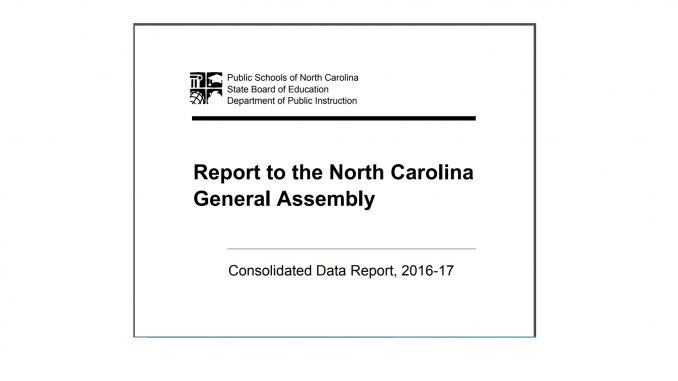
Dropout Rate Up Slightly
North Carolina public schools reported fewer overall incidences of crime and violence during the 2016-17 school year from the previous year, continuing a long-term decline in numbers of offenses, according to the NC Department of Public Instruction’s 2016-17 Consolidated Data Report presented Wednesday, February 28, 2018 to the State Board of Education.
The report also shows a decline in numbers of both short- and long-term suspensions and expulsions. The numbers of students dropping out of high school grades was up slightly, resulting in a marginal increase in the state’s dropout rate, from 2.29% in 2015-16 to 2.31% in 2016-17.
Overall, the total number of reportable crimes across all grades decreased by 1.9% in 2016-17 from the previous year, with the rate per 1,000 students declining by 2.1%, from 6.62% to 6.48% In all, 9,834 offenses were reported last year, down from 10,020 in 2015-16 and from 10,630 in 2012-13.
“This report gives us good context as we continue to explore ways to make schools a safe environment for every student and educator,” said Mark Johnson, state superintendent.
Among high school students, who account for more than half of all reportable offenses, the number of reportable crimes declined by 4% and the rate per 1,000 students improved to 12.12 from 12.75, a decrease of 4.9%.
Schools are required to report 16 offenses that occur on campus or school property, of which nine are considered dangerous and violent. In 2016-17, those nine categories represented 278 individual instances, or 2.8% of all 9,834 reported offenses.
Among the most frequently reported offenses, illegal possession of a controlled substance declined last year to 4,289 from 4,639 the year before; possession of a weapon other than a firearm remained virtually unchanged at 2,745, and assault on school personnel increased to 1,431 from 1,329. Possession of alcoholic beverages declined to 882 from 934 in the previous year.
Other key findings of the 2016-17 Consolidated Data Report show that:
Reportable Acts of School Crime
- 1,127 schools (43% of all) reported no offenses, and 966 schools (37%) reported no more than five.
- Four districts — Alleghany, Graham, Hyde, and Jones county schools — reported no acts at the high school grades.
Short-Term Suspensions
- The number of out-of-school short-term suspensions (one to 10 days) given to students decreased 3.9% — from 216,895 (total in 2015-16) to 208,539 in 2016-17.
- Of those, 83,300 short-term suspensions were reported for students in high school grades statewide in 2016-17, a decrease of 5.9% from the 2015-16 total of 88,559. The grade 9-13 short-term suspension rate was 1.82 suspensions per ten students.
- About one out of 13 NC students received at least one out-of-school short-term suspension in 2016-17. Among high school students only, this ratio was about one out of ten students. Many suspended students receive only one suspension each year, but some students receive multiple short-term suspensions.
Long-Term Suspensions
- The number of long-term suspensions (11 or more days) declined from 1,036 (in 2015-16) to 695 in 2016-17, a decrease of 32.9%. Average school days per suspension decreased from 76.6 to 73.9 school days. High school students received 458 long-term suspensions, a 34.8% decrease from 2015-16.
- The 695 long-term suspensions in 2016-17 were given to 682 different students (i.e., some students were long-term suspended more than once). Long-term suspensions in the state in 2016-17 totaled 51,331 days.
Expulsions
- Eighteen students were expelled from NC schools in 2016-17, a 33.3% decrease from the 27 recorded in 2015-16. High school students received 17 of the 18 expulsions.
Corporal Punishment
- Two NC school districts reported using corporal punishment in 2016-17: Graham and Robeson.
- Corporal punishment was applied 66 times to males and 9 times to females during the 2016-17 school year, and the use of corporal punishment was highest in fourth grade, followed by 11th, 12th, and eighth grades. (Ed. Note: This totals 75, for which the race/ethnicity list is included below.)
- The top three reasons for administering corporal punishment were Leaving/Skipping School, 24; Insubordination, 16; Aggressive Behavior, 11. (Ed. Note: This equals 51. For the other 24 times, the reasons are listed in the report.)
Uses of Corporal Punishment by Race/Ethnicity
American Indian 41
White 30
Black 2
Hispanic 2
Multiracial 0
Asian 0
Pacific Islander 0
State Total 75
Corporal punishment was applied 65 times to non-disabled students and 10 times to students with disabilities. One student was punished three times. American Indian students received 55% of all corporal punishments.
The full NC Public Schools report detailing district-by-district data on all of these measures is available online.
Ed. Note: Emphasis and additional report facts have been added to the release provided by Public Schools of North Carolina. NC parents and stakeholders are encouraged to review the report and see its additional details.


